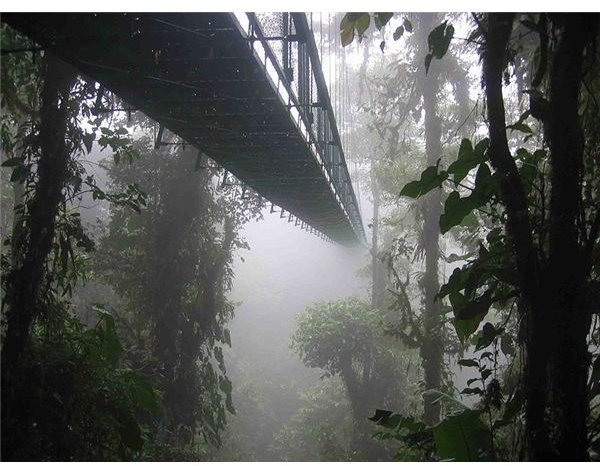Four Collaborative Activities for Teaching on Costa Rica into the Classroom
Costa Rica
Costa Rica, a tiny country in Central America, is the home of indigenous people, tropical rainforests and endangered species. Collaborative activities for incorporating Costa Rica into the classroom give educators the opportunity to teach a holistic unit on this interesting country.
The activities for this unit on Costa Rica are for grades 4-6. They should take several weeks to complete. Subject matter incorporated into the lesson plans include, but are not limited to, history, science, art, language arts and Spanish.
Objectives of Collaboration
The objectives of a collaborative unit on Costa Rica are:
- students discover, across curriculum, facts on Costa Rica
- students learn about the rainforest and environmental issues
- students report on various aspects Costa Rica
- students demonstrate understanding and comprehension of beginning Spanish
Prior Knowledge
Begin by asking the students to brainstorm what they know about Costa Rica. Create a mind map of their answers on the board. Ask a student to show the class where Costa Rica is on the map. Have a map of Costa Rica available for later exploration. (Hint: National Geographic has wonderful maps that include demographics as well as other information.)
WebQuest
Activity #1
Send students on a WebQuest. Divide them into groups of four with each person being assigned a different duty, which are:
- Geographer – reports on the geography of Costa Rica, including types of climate, types of topography and endangered biomes.
- Historian – reports on the history of Costa Rica, including type of government, symbolism of flag and any major events of interest.
- Scientist – reports on the rainforest, coastline and other biomes in Costa Rica, as well as endangered species.
- Sociologist – reports on the culture, art and languages of Costa Rica. This will include finding at least five phrases spoken in Spanish daily.
Prior to beginning, discuss with students what websites give solid information (i.e., .edu, .gov, .org). Give students a specific length of time (one week) to do the research. Have them list the URLs of sites where they find information. They turn in their lists at the end of the unit.
Once complete, ask each group to put together a presentation with artifacts, sharing what they learned. Allow students to use all means available for their presentation (i.e., PowerPoint, video, audio recordings, etc.). Encourage them to label their artifacts in both English and Spanish. Their presentations will be due on the last day of the unit when the class hosts a Tour of Costa Rica Day.
Rainforest
Activity #2
Students will research the rainforest in their WebQuests; however, this lesson gives everyone the opportunity to understand the importance of conserving and protecting this fragile ecosystem. This is an arts/language arts project.
Supplies needed:
- art paper
- pencils
- paints, markers, colored pencils
- various picture books of the rainforest
- writing paper
Have students search through the books until they find a picture that appeals to them. Spend some time discussing what the pictures mean to the students. Assist them in understanding the importance of rainforests and the creatures that live there.
Ask students to each create a pencil sketch of a plant or animal that they found interesting in their search through the books. This is only a sketch — it should be something that is quick and simple. Once done, have students pair off and exchange pictures with their partners. Now, ask students to write a short poem (Haiku works well for this activity) inspired by their partner’s sketch.
Once the poems are written, have students develop their sketches into completed works of art using whatever medium they prefer (watercolors, markers, etc.).
Hang the pictures, along with the poems they inspired, for Costa Rica Day.
Historic Time Line
Activity #3
This social studies lesson gives all students the opportunity to discover important facts about Costa Rica.
Create a timeline that spans the circumference of the classroom with key dates spaced evenly apart from one another. Assign each student a date to research. Have students create information cards, placing them beside each date. Have them use both text and pictures for their cards.
Sea Turtles
Activity #4
The sea turtle is one of the endangered species of Costa Rica. For this science lesson, provide books on the sea turtle that are both informative and interesting.
Ask each student to find two or three facts about sea turtles. Have them write them down. Have students share their facts; make note of duplicates. If you have one unique fact for each student, ask him or her to create sentence cards of the fact for a learning wall on the sea turtle. If there are not enough facts for each student to do their own, divide students up, giving some sentence cards for turtle facts. Ask the others to create a list of other endangered species, making word cards of those species’ names.
Assessment
Informally assess students in this unit by noting participation in each of the activities, their ability to share their knowledge with others at the end of the unit, the completeness of their final project, and ability to participate in question and answer session at the end of the presentation. Formally assess students’ resource lists.
The activities for incorporating Costa Rica into the classroom are challenging, interesting and fun. Students enjoy sharing their knowledge, which makes the final project a highly anticipated event.
References:
- Some content from author’s own experience.
- WebQuest: Costa Rica, 2006, https://www2.needham.k12.ma.us/nhs/nhs_media/NHSLibrary/stulinks/costarica/costarica.html
- Photo Credit: Costa Rica Santa Elena Skywalk by Dirk van der Made under CC by 1.0
Resources:
- National Geographic: Maps, 2011, https://shop.nationalgeographic.com/ngs/category/maps
- Costa Rican Trails: Basic Language, https://www.costaricantrails.com/cr/cr07.html
- Earth Watch: Costa Rican Turtles, 2011, https://www.earthwatch.org/exped/paladino.html
- Costa Rica: Welcome to Costa Rica, 2011, https://www.visitcostarica.com/ict/paginas/home.asp?ididioma=2
- US Department of State: Costa Rica, 2011, https://www.state.gov/r/pa/ei/bgn/2019.htm
